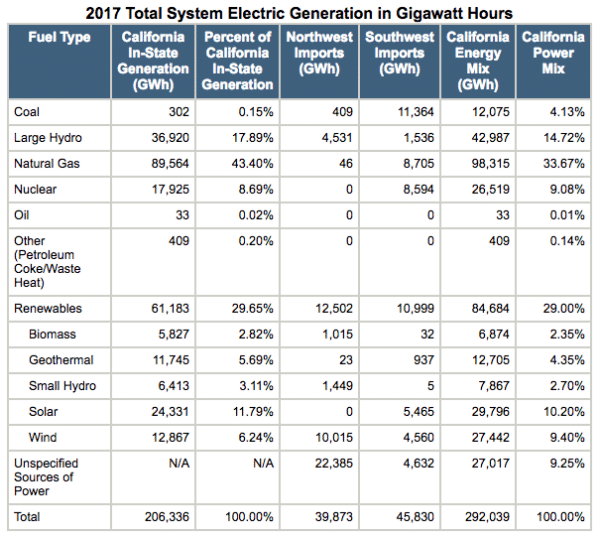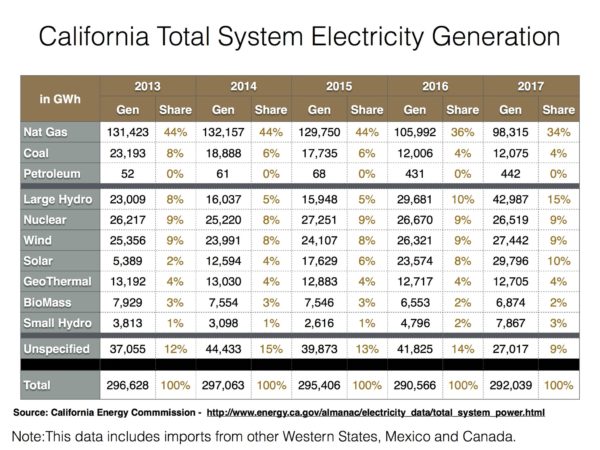California has been the national leader in the energy transition, and in many ways has even led the world – even if outpaced by smaller nations such as Denmark and Uruguay. However, critics have long pointed to the large amount of electricity imported by the state – nearly 1/3 of all power consumed – to allege that the state’s power is not as clean as claimed.
Last week the California Energy Commission largely debunked those concerns with new data that shows that the state’s electricity mix remains largely clean, even with imports. According to Total System Electric Generation, in 2017 wind was the largest source of imports at 14.6 terawatt-hours (TWh), as part of 23.5 TWh of imported renewable energy.

Coal was the second-largest single source of imported power at 11.8 TWh. However, as the state has only a tiny amount of in-state coal generation, even with imports coal represented only 4.1% of California’s power in 2017 – compared to 30% in the nation overall.
In fact, despite the state’s abundant solar power – representing 11.8% of in-state generation in 2017, as one of only three states to exceed 10% – California imported 5.5 TWh of solar from the Southwest.
There is one significant hole in CEC’s data, in that it shows 28.0 TWh of imports – nearly a third of the total – as “unspecified”. The large majority of that power is from the Northwest, which is dominated by hydroelectric power but also has wind and coal-fired power plants.
Either way, California’s mix is getting cleaner over time. The following chart, assembled by frequent pv magazine collaborator and self-described data geek Joe Deely, shows that even with imports solar and large hydro are crowding out coal and gas.

BTM MIA
It is also notable that this data misses behind-the-meter (BTM) solar. CEC does not count the output of any plants smaller than 1 MW, meaning that such data must be found elsewhere. And while CEC’s numbers do not square with those of the U.S. Department of Energy’s Energy Information Administration (EIA), EIA estimates that small-scale solar photovoltaic (PV) generation in California was 10.6 TWh during the year, or around 1/3 of total PV generation.
If you assume another 10.6 TWh of small-scale solar, this would make solar more than 13% of all generation – including imports – and renewables including large hydro rise to over 46% of all power consumed in the state.
These numbers come as California struggles to incorporate large amounts of solar with limited flexibility in the rest of system. In fact, California’s grid operator is showing a net import balance even during hours of record solar penetration, which experts say is the result of inflexible contracts with out-of-state generators.
The solution to this is a subject of debate, as clean energy advocates are divided over whether or not to participate in the creation of a regional Western wholesale power market. These issues are explored in detail in an article in the July edition of pv magazine’s global print magazine.
This content is protected by copyright and may not be reused. If you want to cooperate with us and would like to reuse some of our content, please contact: editors@pv-magazine.com.









By submitting this form you agree to pv magazine using your data for the purposes of publishing your comment.
Your personal data will only be disclosed or otherwise transmitted to third parties for the purposes of spam filtering or if this is necessary for technical maintenance of the website. Any other transfer to third parties will not take place unless this is justified on the basis of applicable data protection regulations or if pv magazine is legally obliged to do so.
You may revoke this consent at any time with effect for the future, in which case your personal data will be deleted immediately. Otherwise, your data will be deleted if pv magazine has processed your request or the purpose of data storage is fulfilled.
Further information on data privacy can be found in our Data Protection Policy.